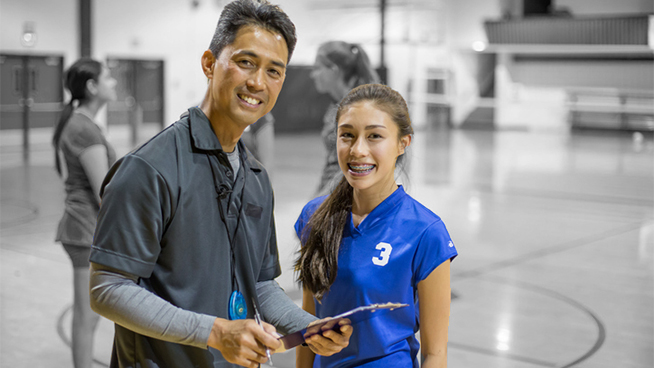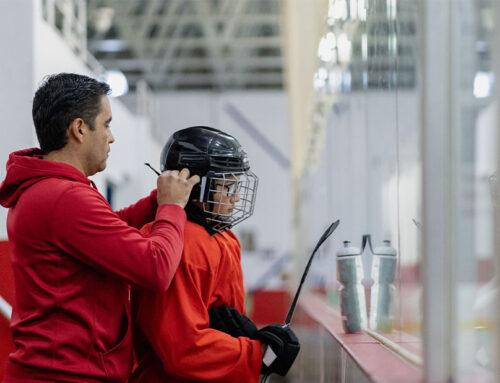How To Coach Middle School Volleyball
Coaching any sport takes time, dedication, and continued personal growth. Coaching is not for everyone, but with planning, organization, and a willingness to learn, it is a skill that can be fine-tuned. Coaching volleyball at the middle school level certainly can provide a host of challenges. You may have years of playing experience or a lifelong love of the sport, but these traits alone won’t equal success as a coach or your team.
Often for athletes joining the middle school volleyball team, this may be their first foray into an organized school sport. They may have played in recreational leagues or built a love of the sport playing with friends and family. This is not only an opportunity for them to play, but an opportunity to develop skills, learn how to be part of a team, self-organization, and how to work with a coach.

And as the coach, you need to understand the game. One of the best tactics you can do is watch volleyball. Watch or review NCAA National Championship games, Olympic matches, or simply attend local games within your community. Study how other coaches, players, and teams operate. There will always be something new you can observe. You can also join organizations that may have reference material, meetings, and other coaches you can brainstorm with. One great resource is USA Volleyball.
As a middle school volleyball coach, you should not only be a fan of the sport, but you should be able to demonstrate and understand basic skills and drills. The coach should be able to demonstrate and instruct the five basic skills of volleyball: serving, passing, setting, hitting, and blocking. Remember, you are dealing with a mixed group of athletes. At the middle school level, players may have had some or little exposure to the sport. Also, young men and women’s bodies are changing, and you’ll have a range of abilities and challenges as these athletes learn how to play and adapt as they grow.
Middle School Volleyball Drills
When setting up practices, consider the following drills to help your team learn all positions, learn how to communicate with you and the teammates, and build confidence with play and rules of the sport:
Six players on the court at a time.
You will have more than six athletes on your team for sure, but they need to learn that everyone must sit out at times. Not every player can be on the court at once and everyone should be given equal playing time. Sitting out and rotating players in allows for rest, allows them to observe the play at hand, and creates the expectation they will be sitting out at times during actual games.
Do not touch the net.
Yes, there are rules and situations when this is permitted or necessary, but at this stage, it is safer and simpler to have the players avoid touching the net during play. There will be time to introduce this or advance to high school or club level.
One-touch.
Once a player has touched the ball, another teammate must have contact with the ball before they can touch it again.
Three touches per side.
Have the players work on three touches before sending the ball over the net. This will help your athletes work on the concepts of passing, setting, and hitting. With every touch, the ball does not necessarily need to go over the net.
Play every position.
Rotate players through every position on the court. This will help them learn about each position, work on skill and play for each, and better understand how to play the game.
It will also be beneficial to work on the three basic offensive systems and two defensive systems.
Volleyball Offensive Systems:
- 6-2 (shorthand for 6 players who primarily hit and 2 who set. The setter sets while in the back row).
- 5-1(shorthand for 5 players who primarily hit and 1 who sets. There is one setter who sets when they are in the front row and back row).
- 4-2 (shorthand for 4 players who primarily hit and 2 who set. The setter sets while in the front row).
Volleyball Defensive Systems:
- Perimeter defense
- Rotation defense
For additional lessons, resources, and tools, visit the coach education tab on USA Volleyball.
And as a middle school volleyball coach, you must be a master at communication. You need to set clear goals and expectations for your athletes. You will also need to communicate with parents and school officials. These young athletes will rely upon friends and family for transportation to and from practices and games. Be sure parents understand times and locations for practices and games. And be sure they understand the needs and expectations of their volleyball athlete, including uniform and equipment, playing time expectations, and what should be done outside of the team to fine-tune skills.
As a middle school volleyball team coach, you need to remember these athletes need to be instructed on the basics. You cannot assume they will just pick it up, or rely on the naturally gifted athletes. You need to think back to your earlier days in sports and be the positive force to build a solid foundation future coaches can fine-tune.
RECOMMENDED FOR YOU
How To Coach Middle School Volleyball
Coaching any sport takes time, dedication, and continued personal growth. Coaching is not for everyone, but with planning, organization, and a willingness to learn, it is a skill that can be fine-tuned. Coaching volleyball at the middle school level certainly can provide a host of challenges. You may have years of playing experience or a lifelong love of the sport, but these traits alone won’t equal success as a coach or your team.
Often for athletes joining the middle school volleyball team, this may be their first foray into an organized school sport. They may have played in recreational leagues or built a love of the sport playing with friends and family. This is not only an opportunity for them to play, but an opportunity to develop skills, learn how to be part of a team, self-organization, and how to work with a coach.

And as the coach, you need to understand the game. One of the best tactics you can do is watch volleyball. Watch or review NCAA National Championship games, Olympic matches, or simply attend local games within your community. Study how other coaches, players, and teams operate. There will always be something new you can observe. You can also join organizations that may have reference material, meetings, and other coaches you can brainstorm with. One great resource is USA Volleyball.
As a middle school volleyball coach, you should not only be a fan of the sport, but you should be able to demonstrate and understand basic skills and drills. The coach should be able to demonstrate and instruct the five basic skills of volleyball: serving, passing, setting, hitting, and blocking. Remember, you are dealing with a mixed group of athletes. At the middle school level, players may have had some or little exposure to the sport. Also, young men and women’s bodies are changing, and you’ll have a range of abilities and challenges as these athletes learn how to play and adapt as they grow.
Middle School Volleyball Drills
When setting up practices, consider the following drills to help your team learn all positions, learn how to communicate with you and the teammates, and build confidence with play and rules of the sport:
Six players on the court at a time.
You will have more than six athletes on your team for sure, but they need to learn that everyone must sit out at times. Not every player can be on the court at once and everyone should be given equal playing time. Sitting out and rotating players in allows for rest, allows them to observe the play at hand, and creates the expectation they will be sitting out at times during actual games.
Do not touch the net.
Yes, there are rules and situations when this is permitted or necessary, but at this stage, it is safer and simpler to have the players avoid touching the net during play. There will be time to introduce this or advance to high school or club level.
One-touch.
Once a player has touched the ball, another teammate must have contact with the ball before they can touch it again.
Three touches per side.
Have the players work on three touches before sending the ball over the net. This will help your athletes work on the concepts of passing, setting, and hitting. With every touch, the ball does not necessarily need to go over the net.
Play every position.
Rotate players through every position on the court. This will help them learn about each position, work on skill and play for each, and better understand how to play the game.
It will also be beneficial to work on the three basic offensive systems and two defensive systems.
Volleyball Offensive Systems:
- 6-2 (shorthand for 6 players who primarily hit and 2 who set. The setter sets while in the back row).
- 5-1(shorthand for 5 players who primarily hit and 1 who sets. There is one setter who sets when they are in the front row and back row).
- 4-2 (shorthand for 4 players who primarily hit and 2 who set. The setter sets while in the front row).
Volleyball Defensive Systems:
- Perimeter defense
- Rotation defense
For additional lessons, resources, and tools, visit the coach education tab on USA Volleyball.
And as a middle school volleyball coach, you must be a master at communication. You need to set clear goals and expectations for your athletes. You will also need to communicate with parents and school officials. These young athletes will rely upon friends and family for transportation to and from practices and games. Be sure parents understand times and locations for practices and games. And be sure they understand the needs and expectations of their volleyball athlete, including uniform and equipment, playing time expectations, and what should be done outside of the team to fine-tune skills.
As a middle school volleyball team coach, you need to remember these athletes need to be instructed on the basics. You cannot assume they will just pick it up, or rely on the naturally gifted athletes. You need to think back to your earlier days in sports and be the positive force to build a solid foundation future coaches can fine-tune.










